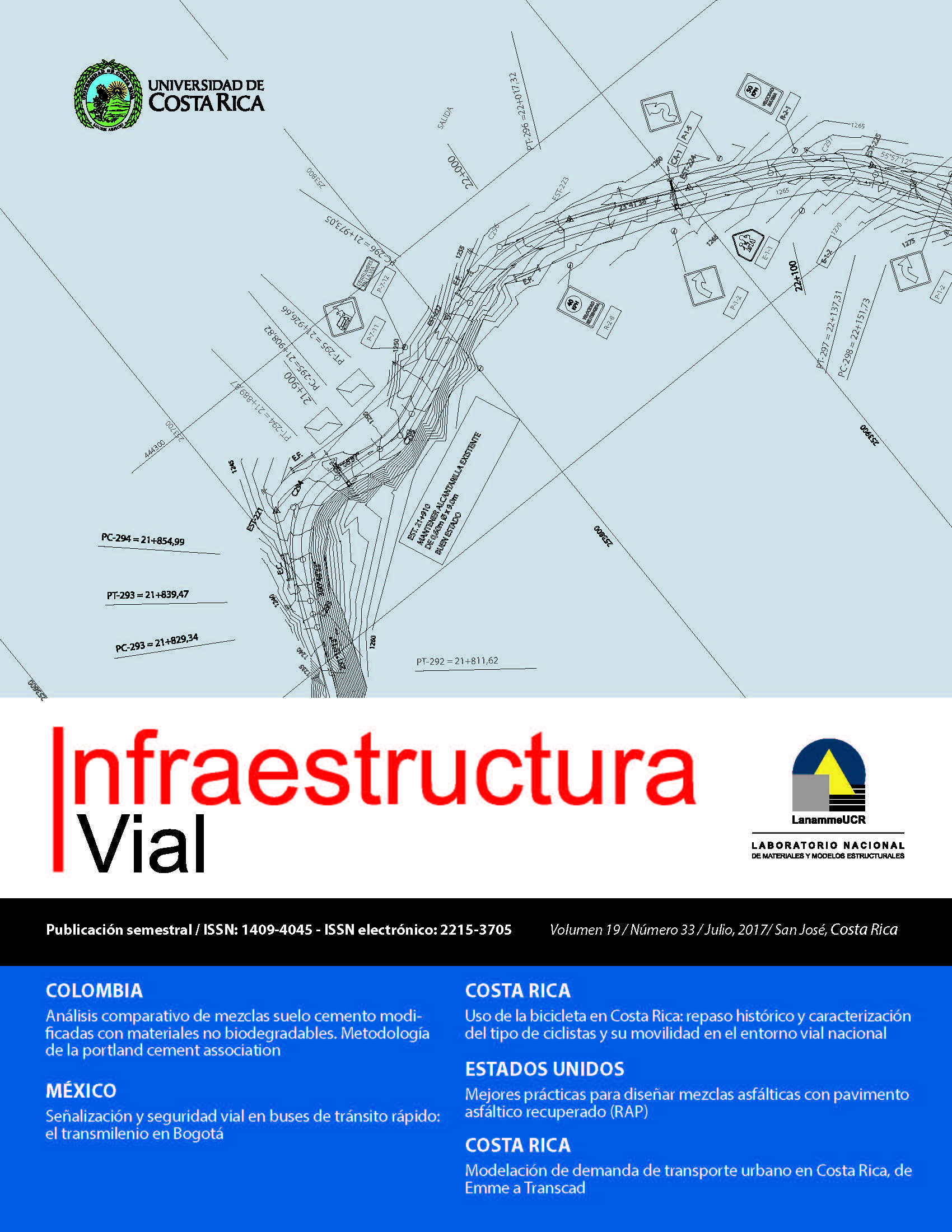Resumen
La utilización de pavimento asfáltico recuperado (RAP en inglés) en carreteras se ha convertido en una estrategia importante para ayudar a compensar el aumento del precio de las materias primas y mejorar la sostenibilidad de la infraestructura de transporte. La forma de caracterizar los materiales de reciclado, el diseño de mezcla, los ensayos de desempeño y las prácticas constructivas no siguen ninguna práctica estándar conocida. El objetivo de este estudio fue el identificar las mejores prácticas para el diseño y producción de mezclas asfálticas con RAP. El documento propuesto proporciona una guía para el uso eficaz de los materiales de RAP e incluye recomendaciones sobre la manipulación y el almacenamiento del RAP, ensayos de este material, producción de mezclas que contienen RAP, y las prácticas de control de calidad durante la producción de las mezclas que contienen RAP.
Citas
Copeland, A. Reclaimed Asphalt Pavement in Asphalt Mixtures: State of the Practice. Report No. FHWA-HRT-11-021, Federal Highway Administration, McLean, Virginia, 2011.
Kandhal, P. and Mallick, R.B. Pavement Recycling Guidelines for State and Local Governments—Participant’s Reference Book, Report No. FHWA-SA-98-042, Federal Highway Administration, Washington, DC, 1997.
McDaniel, R. and T. Nantung. Designing Superpave Mixes with Locally Reclaimed Asphalt Pavement: North Central States Jointly Fund Study. TR News, No. 239, National Academies, Washington, D.C., 2005, pp. 28–30.
National Technology Development, LLC. Quantify the Energy and Environmental Effects of Using Recycled Asphalt and Recycled Concrete for Pavement Construction. Phase I Final Report. Report No. C-08-02, NYS Department of Transportation, 2009.
Solaimanian, M. and M. Tahmoressi. Variability Analysis of Hot-Mix Asphalt Concrete Containing High Percentage of Reclaimed Asphalt Pavement. Journal of the Transportation Research Board, No. 1543, National Academies, Washington, D.C., 1996, pp. 89–96.
F. Zhou, G. Das, T. Scullion, and S. Hu. RAP Stockpile Management and Processing in Texas: State of the Practice and Proposed Guidelines. Report 0-6092-1, Texas Transportation Institute, College Station, Texas, 2010.
West, R., J.R: Willis and M. Marasteanu. "Improved Mix Design, Evaluation, and Materials Management Practices for Hot Mix Asphalt with High Reclaimed Asphalt Pavement Content". NCHRP Report 752, Transportation Research Board, Washington, D.C., 2013.
Chesner, W.H., R.J. Collins and M.H. MacKay. "User Guidelines for Waste and Byproduct Materials in Pavement Construction". Publication No. FHWA-RD-97-148, Federal Highway Administration, McLean, VA, 1998.
Bahia, H.U., Hanson, D.I., Zeng, M., Zhai, H., Khatri, M.A., Anderson, R.M., Characterization of Modified Asphalt Binders in Superpave Mix Design, NCHRP Report No. 459, 2001, NCHRP.
Morales, R., Velasquez, R., and Bahia, H. U. Measuring the Effect of Moisture on Asphalt–Aggregate Bond with the Bitumen Bond Strength Test. In Transportation Research Record: Journal of Transportation Research Board, No. 2209, Transportation Research Board 1 of the National Academies, Washington, D.C., 2011.
Aguiar-Moya, José Pablo, Loria-Salazar, Luis, Salazar, Jorge, Corrales-Azofeifa, Jose, Villegas, Ernesto, Corrales-Azofeifa, José P, Hajj, Elie Y. Evaluation of Adhesion Properties of Costa Rican Asphalt Mixtures using the Bitumen Bond Strength (BBS) and Contact Angle Measurement Tests. Transportation Research Board Annual Meeting 2013 Paper #13-0743, Washington DC.
Coats, A. W.; Redfern, J. P., Thermogravimetric Analysis: A Review. Analyst 88: 906–924. 1963.
Leiva-Villacorta, Fabricio, Villegas-Villegas, Rafael, Aguiar-Moya, José, Salazar-Delgado, Jorge, Loría-Salazar, Luis; Effect of Aging on Rheological, Chemical, and Thermodynamic Properties of Asphalt Components. Transportation Research Board Annual Meeting 2014 Paper #14-4668, Washington DC.
Elseifi, M., Mohammad, L.N., Glover, I., Negulescu, I., Daly, W.H., and Abadie, C.,Relationship between Molecular Compositions and Rheological Properties of Neat Asphalt Binder at Low and Intermediate Temperatures, Journal of Materials in Civil Engineering, 2010.
Bahia, H. U. and D. A. Anderson. Glass Transition Behavior and Physical Hardening of Asphalt Binders. Journal of the Association of Asphalt Paving Technologists, Vol. 62, 93-129. 1993.
Thermo Nicolet Corporation. Introduction to Fourier Transform Infrared Spectroscopy. 2001.
Kuptsov, A.H. Applications of Fourier Transform Raman Spectroscopy in Forensic Science. Journal of Forensic Sciences, JFSCA, Vol. 39, No. 2, pp. 305-318. 1994.
J. F. Masson, L. Pelletier, P. Collins, Rapid FTIR method for quantification of styrene-butadiene type copolymers in bitumen. Journal of Applied Polymer Science 79, 1034 – 1041. 2001.
Norin M, Strömvall AM. Leaching of organic contaminants from storage of reclaimed asphalt pavement. Environ Technol. 2004 Mar;25(3):323-40.
Legret M1, Odie L, Demare D, Jullien A., Leaching of heavy metals and polycyclic aromatic hydrocarbons from reclaimed asphalt pavement. Water Res. 2005 Sep;39(15):3675-85.
P. Campíns-Falcó, J.Verdú-Andrés, A.Sevillano-Cabeza, R. Herráez-Hernández, C. Molins-Legua, Y. Moliner-Martinez, J. Chromatogr. A 1217 (2010) 2695-2702.
C. Cháfer – Pericás, P. Campíns-Falcó y M.C. Prieto-Blanco, Automatic in-tube SPME and fast liquid chromatography. A 610, 268-272 (2008) Holanda.
Shen, S., and S. Carpenter, Application of Dissipated Energy Concept in Fatigue Cracking Endurance Limit Testing, Transportation Research Record No. 1929, Washington D. C., 2005, pp. 165-178.
Shu, X., B. Huang, and D. Vukosavljevic, Laboratory Evaluation of Fatigue Characteristics of Recycled Asphalt Mixture, Construction and Building Materials, 2007.
Monismith, C., Kenneth, E, and E. Blachmen, Asphalt Behaviour in Repeated Flexure, Proceedings of the Association of Asphalt Paving Technologists, v. 30, 1961.
Vargas-Nordcbeck, Adriana. Watson Donald E.; Moore Jason; Jared David; Wu PeterEvaluation of the Use of Reclaimed Asphalt Pavement in Stone Matrix Asphalt Mixtures. Transportation Research Record: Journal of the Transportation Research Board, Issue 2051, 2008, pp 64-70.
Mohammad, L., Wu, Z., Obulareddy, S. , Cooper, S., and AbadieC., Permanent Deformation Analysis of Hot-Mix Asphalt Mixtures with Simple Performance Tests and 2002 Mechanistic-Empirical Pavement Design Software”, Transportation Research Record, No. 1970, (2006).
Drescher, A., Kim, J. R., and D. E Newcomb, Permanent Deformation in Asphalt Concrete, Journal of Materials in Civil Engineering, Vol. 5, Issue 1, 1993 p. 112-128.
MOPT Manual de Especificaciones Generales para la Construcción de Carreteras, Caminos y Puentes. “División 400. Pavimentos Asfálticos y Tratamientos Superficiales.” Designación MOPT: CR-2010. San José, Costa Rica, 2010.
LM-PI-UMP-016-R1. Propuesta Mezcla Asfáltica en Caliente División 400 CR-2010, LanammeUCR, Junio, 2013.


